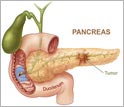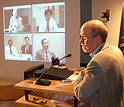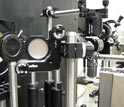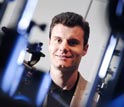News Release 09-030
Determining Risk for Pancreatic Cancer
Experimental technique safely differentiates patients with pancreatic cancer, precursor lesions and benign tumors
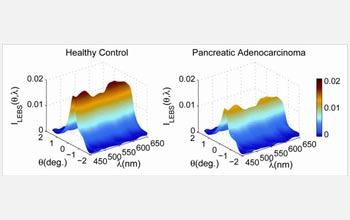
Measurements of light scattering off of benign tissue differ from those of cancerous tissue.
February 23, 2009
For a broadcast quality b-roll package including interviews, lab footage and animations, contact Dena Headlee at dheadlee@nsf.gov.
This material is available primarily for archival purposes. Telephone numbers or other contact information may be out of date; please see current contact information at media contacts.
In the latest clinical trial for a technique to detect pancreatic cancer, researchers found they could differentiate cells that are cancerous from those that are benign, pre-cancerous, or even early stage indicators called mucinous cystic lesions.
Pancreatic cancer is dangerous to screen for, yet deadly if ignored. The pancreas is extremely sensitive--biopsies can lead to potentially fatal complications--but with few symptoms, the cancer is usually detected too late.
The disease is the fourth largest cause of cancer-related deaths in the United States, with a five-year survival rate of less than 5 percent. If doctors can find ways to identify early precursor lesions, the disease can be prevented in most individuals.
Reporting online Feb. 10, 2009, in the journal Disease Markers, researchers from Northwestern University and Evanston Northwestern Healthcare report convincing results with their minimally invasive methods for detecting pancreatic cancer.
"This technique allows us to detect changes in cells that look normal using microscopy," says co-author Vadim Backman of Northwestern University. "This level of detail allows us to detect cancer in its earliest stages."
Their techniques, called four-dimensional elastic light scattering fingerprinting (4D-ELF) and low-coherence enhanced backscattering spectroscopy (LEBS), identify the cancer and its precursors by analyzing light refracted through cells in the duodenum, a section of the small intestine adjacent to the pancreas.
"I'm excited about this work," said Leon Esterowitz, the National Science Foundation (NSF) biophotonics program director who helped fund this study and the development of the 4D-ELF and LEBS technologies. "I believe these results are very promising, and the techniques have a high probability of success for not just detecting early pancreatic cancer, but pre-cancer, so doctors can go ahead and treat the patient while there's still a chance to defeat the disease." Esterowitz added. "For pancreatic cancer, this could lead to not only an excellent prognosis, but perhaps even a cure."
While earlier success had shown that the techniques could tell cancerous from non-cancerous tissue without resorting to a biopsy, the new study of 203 individuals was the first to show the method can identify various disease stages and risk factors, including a possible signature related to "family history."
The researchers' approach had a sensitivity of 95 percent for determining healthy tissue from cancerous tissue and appears to be the most successful yet developed for detecting pancreatic diseases at curable stages and for identifying high-risk individuals.
"These optical techniques have shown promise for detecting both colon and pancreatic cancer," says Backman. "Our hope is to continue to test the ability to detect other forms of cancer, which would greatly expand the impact of the technology." In ongoing work, the researchers will continue to refine their instrumentation and hope to validate the recent findings with further clinical trials.
This research was funded with NSF grant CBET-0733868, in addition to support from the V Foundation, the Rolfe Foundation and the National Institutes of Health.
For an earlier press release, see http://www.nsf.gov/news/news_summ.jsp?cntn_id=109781
Also see the Northwestern University press releases at:
http://www.mccormick.northwestern.edu/news/articles/480
http://www.mccormick.northwestern.edu/news/articles/476
http://www.mccormick.northwestern.edu/news/articles/456
http://www.mccormick.northwestern.edu/news/articles/297
-NSF-
-
Signs of pancreatic cancer can be detected by examining tissue from inside the duodenum.
Credit and Larger Version -
View Video
Pancreatic cancer affects intestinal tissue. There are changes at the nano-level, not the cellular.
Credit and Larger Version -
View Video
The researchers and an expert on biophotonics take part in a call-in program hosted by NSF.
Credit and Larger Version -
Researchers can see how light bounces off human tissue to detect potential cancer.
Credit and Larger Version -
One of the systems researchers use to analyze potentially cancerous tissue.
Credit and Larger Version -
Vadim Backman of Northwestern University with some of the equipment he uses to detect cancer.
Credit and Larger Version
Media Contacts
Joshua A. Chamot, NSF, (703) 292-7730, email: jchamot@nsf.gov
Megan Fellman, Northwestern University, (847) 491-3115, email: fellman@northwestern.edu
Kyle Delaney, Northwestern University, (847) 467-4010, email: k-delaney@northwestern.edu
Jim Anthony, NorthShore University HealthSystem, (847) 570-6132, email: janthony@northshore.org
Program Contacts
Leon Esterowitz, NSF, (703) 292-7942, email: lesterow@nsf.gov
Principal Investigators
Vadim Backman, Northwestern University, (847) 467-4010, email: v-backman@northwestern.edu
The U.S. National Science Foundation propels the nation forward by advancing fundamental research in all fields of science and engineering. NSF supports research and people by providing facilities, instruments and funding to support their ingenuity and sustain the U.S. as a global leader in research and innovation. With a fiscal year 2023 budget of $9.5 billion, NSF funds reach all 50 states through grants to nearly 2,000 colleges, universities and institutions. Each year, NSF receives more than 40,000 competitive proposals and makes about 11,000 new awards. Those awards include support for cooperative research with industry, Arctic and Antarctic research and operations, and U.S. participation in international scientific efforts.
Connect with us online
NSF website: nsf.gov
NSF News: nsf.gov/news
For News Media: nsf.gov/news/newsroom
Statistics: nsf.gov/statistics/
Awards database: nsf.gov/awardsearch/
Follow us on social
Twitter: twitter.com/NSF
Facebook: facebook.com/US.NSF
Instagram: instagram.com/nsfgov

